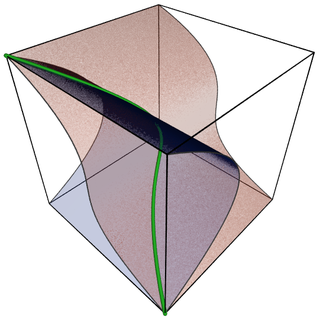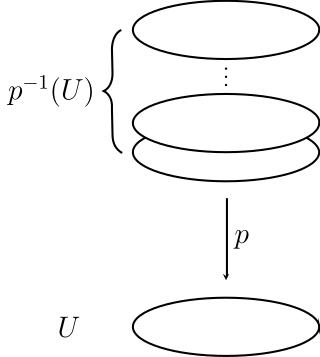In the mathematical field of algebraic topology, the fundamental group of a topological space is the group of the equivalence classes under homotopy of the loops contained in the space. It records information about the basic shape, or holes, of the topological space. The fundamental group is the first and simplest homotopy group. The fundamental group is a homotopy invariant—topological spaces that are homotopy equivalent have isomorphic fundamental groups. The fundamental group of a topological space is denoted by .
In the mathematical field of topology, the Alexandroff extension is a way to extend a noncompact topological space by adjoining a single point in such a way that the resulting space is compact. It is named after the Russian mathematician Pavel Alexandroff. More precisely, let X be a topological space. Then the Alexandroff extension of X is a certain compact space X* together with an open embedding c : X → X* such that the complement of X in X* consists of a single point, typically denoted ∞. The map c is a Hausdorff compactification if and only if X is a locally compact, noncompact Hausdorff space. For such spaces the Alexandroff extension is called the one-point compactification or Alexandroff compactification. The advantages of the Alexandroff compactification lie in its simple, often geometrically meaningful structure and the fact that it is in a precise sense minimal among all compactifications; the disadvantage lies in the fact that it only gives a Hausdorff compactification on the class of locally compact, noncompact Hausdorff spaces, unlike the Stone–Čech compactification which exists for any topological space.

An exact sequence is a sequence of morphisms between objects such that the image of one morphism equals the kernel of the next.
In mathematics, a sheaf is a tool for systematically tracking data attached to the open sets of a topological space and defined locally with regard to them. For example, for each open set, the data could be the ring of continuous functions defined on that open set. Such data are well behaved in that they can be restricted to smaller open sets, and also the data assigned to an open set are equivalent to all collections of compatible data assigned to collections of smaller open sets covering the original open set.

Algebraic varieties are the central objects of study in algebraic geometry, a sub-field of mathematics. Classically, an algebraic variety is defined as the set of solutions of a system of polynomial equations over the real or complex numbers. Modern definitions generalize this concept in several different ways, while attempting to preserve the geometric intuition behind the original definition.

In topology, a covering or covering projection is a surjective map between topological spaces that, intuitively, locally acts like a projection of multiple copies of a space onto itself. In particular, coverings are special types of local homeomorphisms. If is a covering, is said to be a covering space or cover of , and is said to be the base of the covering, or simply the base. By abuse of terminology, and may sometimes be called covering spaces as well. Since coverings are local homeomorphisms, a covering space is a special kind of étale space.
The notion of a fibration generalizes the notion of a fiber bundle and plays an important role in algebraic topology, a branch of mathematics.
A CW complex is a kind of a topological space that is particularly important in algebraic topology. It was introduced by J. H. C. Whitehead to meet the needs of homotopy theory. This class of spaces is broader and has some better categorical properties than simplicial complexes, but still retains a combinatorial nature that allows for computation. The C stands for "closure-finite", and the W for "weak" topology.
In field theory, the primitive element theorem states that every finite separable field extension is simple, i.e. generated by a single element. This theorem implies in particular that all algebraic number fields over the rational numbers, and all extensions in which both fields are finite, are simple.
In category theory, a branch of mathematics, a subobject is, roughly speaking, an object that sits inside another object in the same category. The notion is a generalization of concepts such as subsets from set theory, subgroups from group theory, and subspaces from topology. Since the detailed structure of objects is immaterial in category theory, the definition of subobject relies on a morphism that describes how one object sits inside another, rather than relying on the use of elements.
In category theory, a branch of mathematics, a pullback is the limit of a diagram consisting of two morphisms f : X → Z and g : Y → Z with a common codomain. The pullback is written
In mathematics, hyperfunctions are generalizations of functions, as a 'jump' from one holomorphic function to another at a boundary, and can be thought of informally as distributions of infinite order. Hyperfunctions were introduced by Mikio Sato in 1958 in Japanese,, building upon earlier work by Laurent Schwartz, Grothendieck and others.
In algebraic geometry, the normal cone of a subscheme of a scheme is a scheme analogous to the normal bundle or tubular neighborhood in differential geometry.

In Lie theory and related areas of mathematics, a lattice in a locally compact group is a discrete subgroup with the property that the quotient space has finite invariant measure. In the special case of subgroups of Rn, this amounts to the usual geometric notion of a lattice as a periodic subset of points, and both the algebraic structure of lattices and the geometry of the space of all lattices are relatively well understood.
This is a glossary of algebraic geometry.
In algebraic geometry, a closed immersion of schemes is a regular embedding of codimension r if each point x in X has an open affine neighborhood U in Y such that the ideal of is generated by a regular sequence of length r. A regular embedding of codimension one is precisely an effective Cartier divisor.
In algebraic geometry, a cone is a generalization of a vector bundle. Specifically, given a scheme X, the relative Spec
Arithmetic Fuchsian groups are a special class of Fuchsian groups constructed using orders in quaternion algebras. They are particular instances of arithmetic groups. The prototypical example of an arithmetic Fuchsian group is the modular group . They, and the hyperbolic surface associated to their action on the hyperbolic plane often exhibit particularly regular behaviour among Fuchsian groups and hyperbolic surfaces.
In algebraic geometry, a relative effective Cartier divisor is roughly a family of effective Cartier divisors. Precisely, an effective Cartier divisor in a scheme X over a ring R is a closed subscheme D of X that (1) is flat over R and (2) the ideal sheaf of D is locally free of rank one. Equivalently, a closed subscheme D of X is an effective Cartier divisor if there is an open affine cover of X and nonzerodivisors such that the intersection is given by the equation and is flat over R and such that they are compatible.
Gaussian distribution on a locally compact Abelian group is a distribution on a second countable locally compact Abelian group which satisfies the conditions:















